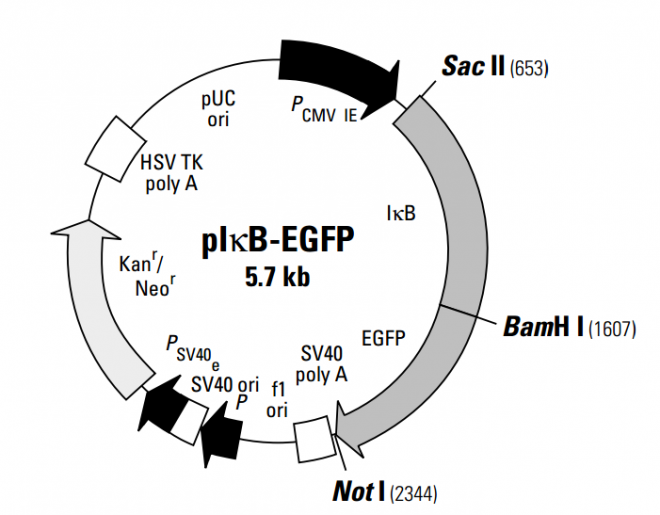pIκB-EGFP 载体
| 质粒类型: | 信号通路报告载体 |
|---|---|
| 启动子: | CMV |
| 克隆方法: | 多克隆位点,限制性内切酶 |
| 载体大小: | 5.7kb |
| 载体标签: | EGFP |
| 载体抗性: | Kanamycin (卡那霉素) |
| 筛选标记: | Neomycin (新霉素) |
The pIκB-EGFP Vector encodes the IκB-EGFP Signaling Probe, which is a fusion of enhanced green fluorescent protein (EGFP) and IκB. IκB is an inhibitor of NFκB, a transcription factor involved in the immune response and inflammatory diseases. When the NFκB pathway is inactive, IκB and NFκB exist as an inactive complex in the cytosol. Upon stimulation, IκB is degraded. In cells transfected with pIκB-EGFP, degradation of the IκB-EGFP fusion protein is observed as a decrease in EGFP fluorescence (1). The IκB-EGFP Signaling Probe is constitutively expressed and resides in the cytosol.
EGFP is a red-shifted, human codon-optimized variant of GFP (2–6) that has been engineered for brighter fluorescence and higher expression in mammalian cells. Its excitation maximum is 488 nm and emission maximum is 509 nm. For more information on the properties of EGFP, please refer to the BD Living Colors™ User Manual (PT2040-1) included with the vector.
Expression of the IκB-EGFP is driven by the human CMV immediate-early promoter. The SV40 poly-A sequence directs proper processing of the 3' end of the fusion construct. The vector backbone also contains an SV40 origin for replication in mammalian cells expressing the SV40 T-antigen. A neomycin resistance cassette (Neor ) allows kanamycin selection in E. coli and neomycin (G418) selection in eukaryotic cells. This cassette consists of the SV40 early promoter, the neomycin/ kanamycin resistance gene of Tn5, and poly-A signals from the Herpes simplex virus thymidine kinase (HSV TK) gene. The vector backbone also provides a pUC origin of replication for propagation in E. coli and an f1 origin for single-stranded DNA production.
载体应用
The IκB-EGFP Signaling Probe can be used to monitor activation of the NFκB signalling pathway by observing changes in EGFP fluorescence. EGFP can be detected by fluorescence microscopy or by flow cytometry. No antibody staining or fixation is necessary.
This vector is not intended for use as a cloning vector; however, there are sites flanking the EGFP and IκB coding regions for subcloning these sequences into other expression vectors. The vector can be transfected into mammalian cells using any standard method. If required, stable transformants can be selected using G418 (7).


